Developing regional future scenarios for heat and gas
To support Wales & West Utilities’ future gas demand forecasting, network analysis and investment planning, Regen has been commissioned to undertake a Network Innovation Allowance funded project. The scope of the project is to develop and trial a new methodology to create a set of regional and sub-regional growth scenarios for gas and heat from a 2018 baseline out to 2035. The intention is that these growth scenarios, backed by extensive analysis and stakeholder engagement, will create a dataset and evidence case to help Wales & West Utilities, and other stakeholders, to understand the future requirements and usage of the gas network.
As well as the need to evidence and justify future network planning and investment decisions, there is also an increasing need for gas and electricity network operators to demonstrate to customers and stakeholders that they are delivering a network to meet a variety of economic and societal objectives. The need for investment to support decarbonisation to reduce the impact of climate change has grown in urgency, alongside a number of other priority areas on network operators such as:
- Supporting a clean growth industrial strategy
- The delivery of local and regional economic strategies
- Providing energy security
- Addressing wider societal issues such as fuel poverty and supporting vulnerable customers
Geographic scope
The remit of the project that Regen is delivering for Wales & West Utilities surrounds the creation of a set of regional future energy scenarios for the gas distribution network in the South West of England and in Wales, specifically relating to Wales & West Utilities’ Local Distribution Zones (LDZs).
The project is being delivered in three phases:
Phase one of the project was completed in Feb 2019 and developed the project scope, methodology and approach to undertaking regional scenario projections for gas and heat.
Phase two, which completed at the end of May, created a set of regional future energy scenarios for gas and heat for the South West LDZ. The draft results were presented at an event in Bristol in May.
Phase three, which Regen began in June, is to develop a similar set of scenario projections for the gas distribution network in Wales, taking in to account the variations in policy environment, topography, on/off gas variation and installed asset base when compared to the South West LDZ.
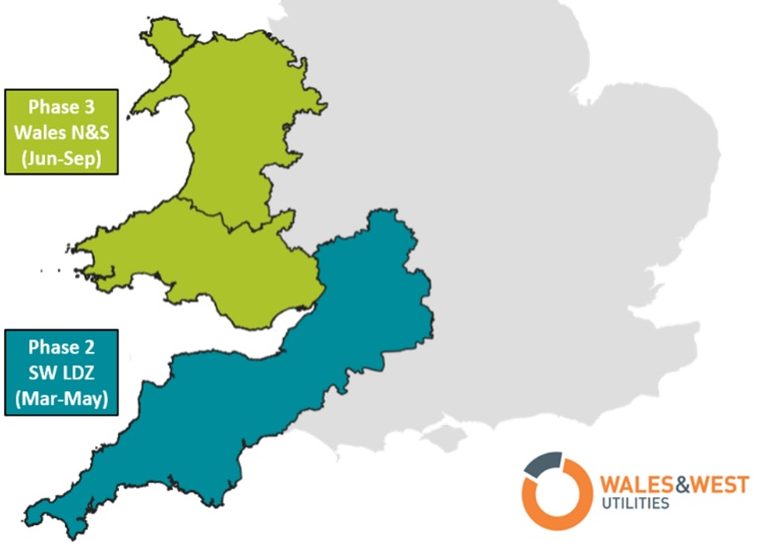
Use and development of future energy scenarios for heat and gas
The project has used and adapted the four National Grid FES 2018 energy scenarios, with the addition of a fifth – Hybrid Accelerator – which has been developed in conjunction with Wales & West Utilities and regional stakeholders. Use of these national scenarios has provided a common framework and an overarching set of assumptions, while the regional scenarios have themselves been developed through a bottom up process of data gathering, energy system analysis and stakeholder engagement for the South West and Wales LDZs.
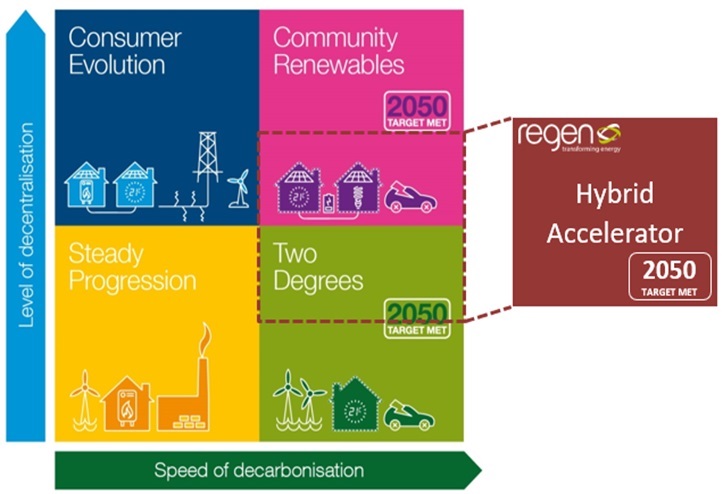
Of the five scenarios used, three (Community Renewables, Two Degrees and Hybrid Accelerator) are intended to be consistent with the UK’s existing commitment to reduce carbon emissions by 80% by 2050. The other two (Steady Progression and Consumer Evolution) would not deliver the required carbon reduction. In the context of recent policy announcements, the three compliant scenarios would not necessarily meet a more ambitious net-zero or 95% emissions reduction target and would not meet more accelerated net zero carbon targets. However, the trajectories of the resultant scenarios developed for this project (out to 2035), could be considered in the context of a 2050 outcome.
Scenario forecasting for key sources of demand and supply
The project considers the energy system holistically, resulting in the creation of forecast projections for over 60 individual gas and heat system elements, which are related to key sources of energy demand and alternative sources of supply.
These elements have been grouped into the following areas:
- Domestic heat demand (including existing dwellings and new housing)
- Non-domestic/commercial heat (including existing and new developments)
- Large gas fired industrial processes
- Gas fired electricity generation
- Gas fuelled transport
- Alternative supplies of gas energy such as biomethane and hydrogen, and unconventional gas
Whilst there are a number of shared assumptions being applied, the approach the project is taking to modelling possible future scenarios to 2035 varies depending on the source of demand or supply. Some of the high-level approaches are outlined below.
1. Domestic heating
For the purpose of this assessment, domestic heat is being considered as the demand for energy to provide space heating and domestic hot water within domestic dwellings. The demand for domestic heat is strongly influenced by a range of factors, such as the type of dwelling, availability of the gas grid, the type of heating appliance and fuel conversion efficiency. The future energy scenario projections for domestic heat have been determined through analysing the following elements:
- Number of dwellings (now and in the future)
- Annual heat demand (considering energy efficiency deployment)
- Diversity of heat delivery technologies (and their conversion efficiency) in domestic dwellings
These elements are modelled to evolve over time to a lesser or greater degree across the five future scenarios described above. Some of the aspects of the modelling for domestic heat that flex, depending on the scenario, include:
- The domestic heat energy demand (related to scale of energy efficiency uptake, e.g. deep retrofit vs continuing the baseline trend)
- Proportion of dwellings with different technologies as their prime (or sole) source of heat and specifically the uptake of low carbon heating technologies being driven by the RHI or other means (e.g. heat pumps)
- Number of dwellings served by heat networks, the efficiency and losses of these networks and the likely fuel that they will run on now (e.g. natural gas) and in the future (e.g. biomass or biomethane)
One of the biggest potential impacts on both the gas and electricity networks could be driven by the potential for existing domestic dwellings to shift their heating technology to a low carbon alternative. Currently in the Wales & West Utilities South West LDZ ,72% of domestic dwellings are heated by gas boilers and in the Wales LDZs this is even higher at 77%. Understanding both the near-term trajectory and the future growth/reduction drivers, is a key feature of the future scenario projections.
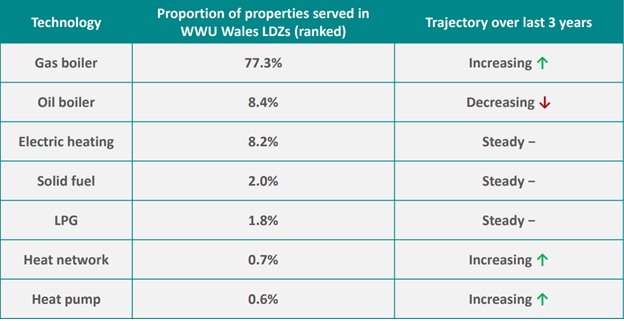
2. Commercial and industrial users
Commercial and industrial heat is considered as the demand for energy to provide space heating and hot water in occupied commercial premises, and the demand for gas for industrial processes. The factors influencing demand for commercial and industrial space heating are similar to domestic heating, with considerations around scale. For industrial processes, demand for gas is influenced primarily by the efficiency of the process and ability to reduce heat losses.
The future energy scenarios for commercial and industrial heat have been determined through analysing the following:
- Number of premises (now and in the future)
- Annual heat and gas demand (considering energy efficiency deployment/process efficiency)
- Diversity of heat delivery technologies in commercial buildings
These elements are similarly modelled to evolve over time to a lesser or greater degree across the future scenarios described. Some aspects of the modelling that flex, depending on the scenario, include:
- The commercial heat energy demand (related to scale of commercial energy efficiency uptake)
- The energy demand from industrial processes (related to process improvements over time)
- Proportion of commercial and industrial premises with different technologies as their prime (or sole) source of heat
- The comparative presence of low carbon heating in commercial premises, compared to the domestic heating sector, potentially due to a lack of incentives on commercial landlords
- The number of commercial premises served by heat networks and the fuel that they run on
The baseline position in the commercial sector is understandably different to domestic heating, with many more premises having their space heating delivered by electrically driven heat technologies such as air conditioning, HVAC and other electric heaters. There is also a stronger potential for commercial premises to connect to and take advantage of future district heating systems.
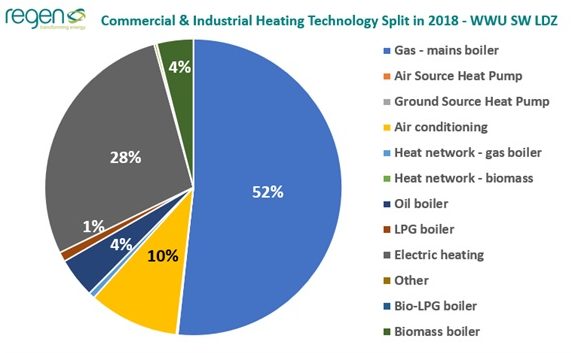
3. Distributed gas fired electricity generation
In the context of this assessment, gas fired power generation scenario analysis encompasses gas distribution network connected sites, whose primary purpose is electricity generation for grid export. The development of distributed gas fired power capacity and operation is driven by a number of factors, such as the type of electricity generating technology, the needs of the electricity system and energy system decarbonisation objectives. The future energy scenario projections for gas fired power generation has been determined through analysing the following key stages:
- Assessment of existing/baseline installed generation capacity (MWe) and the mixture of the type of gas generating technology (CCGT, OCGT or reciprocating engines) for each connected site
- Assessment of the pipeline of known future developments, including their gas generating technology and any relevant planning and Capacity Market activity
- Site capacity factors, annual generation output, gas conversion efficiency and demand for gas
There are a number of aspects of the modelling of future distributed gas generation that flex by scenario, including:
- The potential for larger baseload CCGT/OCGT sites that may be decommissioned out to 2035, due to stringent decarbonisation objectives and the increasing need for rapid start-up
- The pipeline projects (almost entirely reciprocating engine sites) that are or are not likely to come online (and in which year they are commissioned), driven by varying markets and revenue streams (i.e. Capacity Market, Balancing Mechanism, gas/power price arbitrage etc.)
- The typical capacity factor and efficiency of each generating technology type and therefore the resultant annual energy generation output and demand for gas now, and in the future
- The potential for replacing behind-the-meter diesel backup generators with gas engines
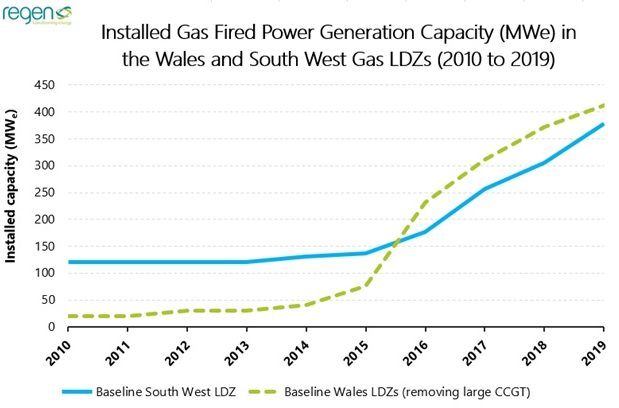
4. Green gas usage and injection
For the purposes of this project, green gas refers to gas produced from sustainable feedstocks or sources, specifically biomethane or biogas. In this context, green gas has multiple potential uses in providing heat, firing industrial processes, power generation and fuelling transport.
The project is therefore considering three main uses of green gas:
- Injection of biomethane into the gas network
- Usage of biomethane/biogas on-site for heat
- Usage of biogas for power generation
In regard to injecting green gas into the network, the gas blend in networks is currently predominantly natural gas (methane), fed from the National Transmission System. However, there has been a slowly increasing proportion of biomethane that is being injected into the distribution networks in certain areas, from commercial operators and injection sites.
In the Wales & West Utilities South West LDZ there are currently 18 biomethane injection sites connected to the network, representing 1.7% of total gas energy supplied (kWh). However, in Wales there is currently only one operational injection site and very limited activity/interest for additional projects seeking to connect and inject green gas in the network Wales into the future.
The growth drivers for green gas production include availability of incentive programmes, such as the RHI in the near-term, other potential future government support, as well as the availability of feedstocks and management of wastes.
In addition to injecting into the network, green gas production is also being used for power generation and onsite heating, especially so in Wales. The abundance of green gas feedstocks and the resultant end use in the context of UK and Welsh government decarbonisation targets are key considerations.
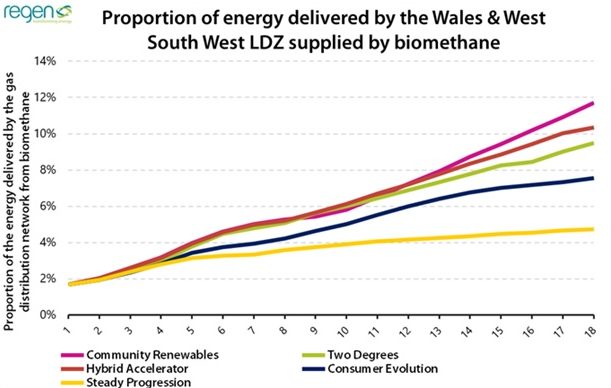
Anaerobic Digestion deployment in Wales
Source: Welsh Government, Energy Generation in Wales 2017 (produced by Regen)
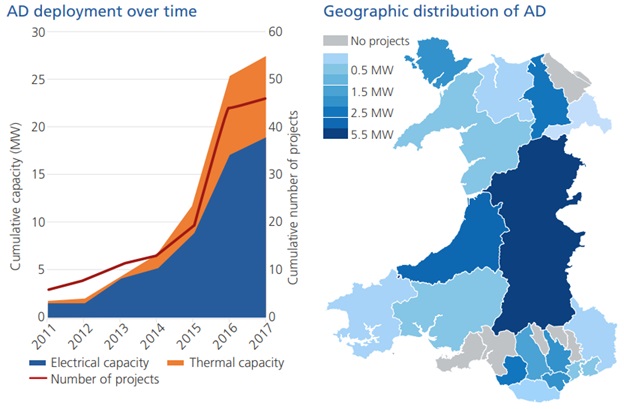
4. Hydrogen production and usage
Alongside biomethane, the production and use of hydrogen provides another potential option for heat decarbonisation in the future. The extent of decarbonisation that hydrogen may provide is dependent on both the method by which the hydrogen is produced and how it is deployed and used.
The method by which hydrogen is produced has not been assessed in much detail. In the context of this scenario analysis out to 2035 in the South West LDZ, production of hydrogen has been assumed to be entirely driven by electrolysis or ‘Green Hydrogen’, sourced from surplus renewable electricity. Given the distance to major gas terminals and limited access to carbon emission storage sites in the South West LDZ, production of hydrogen from Steam Methane Reformation (SMR) with Carbon Capture and Storage (CCS) is less likely and therefore has not been included in the modelling to 2035. However, there is a potentially larger opportunity for hydrogen use in and around commercial and industrial clusters in South and North Wales, so the method of hydrogen production may be more diverse in Wales in some scenarios.
In the context of this project, the supply/use of hydrogen can be categorised by two main methods:
- Hydrogen blending – where hydrogen is directly injected into the gas distribution network
- 100% hydrogen networks – where separate or parallel pipe networks are installed, dedicated to distributing and supplying hydrogen to specific areas i.e. hydrogen city regions
There is no projected hydrogen blending within the distribution gas network in any of the four National Grid FES 2018 scenarios, by 2035, however a modest amount of low-carbon hydrogen blending into the network is been considered in the fifth Hybrid Accelerator scenario.
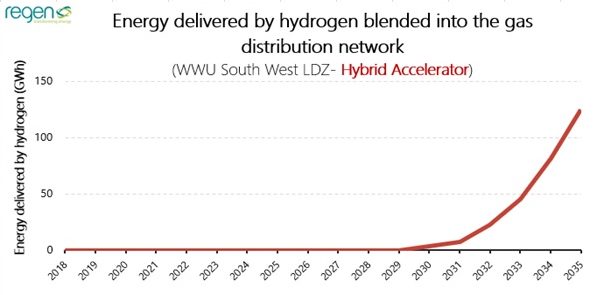
Dedicated networks of 100% low-carbon hydrogen replacing the existing mains gas network could become a significant future technology option for the decarbonisation of heat. A strategic project looking into hydrogen networks, the H21 Project, envisages a region-by-region conversion to hydrogen networks starting with the North of England from 2028 to 2034, and the South Wales and South West major urban areas undergoing conversion in 2036 to 2037. For the context of this assessment, the modelling for the South West LDZ has therefore not included any significant hydrogen networks under any of the five scenarios to 2035.
However, with the existing production of hydrogen in South Wales, other innovation projects and regional strategies outside of the H21 being considered in Wales, there is the potential for hydrogen networks or clusters of industrial hydrogen producers to appear within the timeframe of the assessment.
In-region geographical distribution
The project centres around creating regional scenarios that can be used for strategic gas network planning. This has led to the creation of smaller geographic zones known as Gas Supply Areas (or GSAs) within both the South West and Wales LDZ. There are 63 GSAs in the South West area and 38 GSAs in Wales, as shown in the maps below.
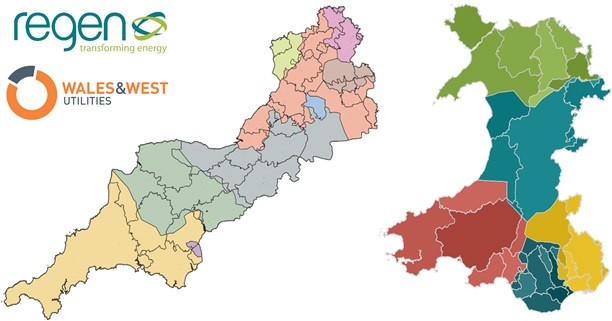
These geographic zones disaggregate the gas distribution network by both local authority boundaries and Wales & West Utilities’ linepack zones – essentially gas network pressure management areas.
The scenario projections developed by Regen are then distributed geographically across these GSAs. This enables Wales & West Utilities to view the scenario projections for each source of demand or supply out to 2035, down to a finer resolution and can help to identify gas demand ‘hot spots’ or potential future constraints around e.g. green gas injection in low demand areas.
Stakeholder engagement
A key part of the project methodology has been to engage with regional and local stakeholders. Regen and Wales & West Utilities hosted workshops in Exeter and Bristol as an opportunity to gather insight and input to develop the regional scenarios for the South West LDZ and recently held a workshop in Cardiff, engaging with a number of key stakeholders about the Wales phase of the project.
These events have sought input and feedback from attendees to:
- Clarify the impacts of key market, policy and technology drivers
- Provide insight on the changing commercial landscape for the use of gas in domestic, commercial and industrial sectors
- Understand the future growth/shrinkage of some of the key elements of the scenario analysis
- ‘Road test’ the approach, data, evidence base and assumptions with a wider audience
A fourth event is being planned in Llandudno in north Wales, to share the draft results from the future energy scenarios for heat and gas in Wales, which the Regen team are currently modelling. More information about this event is available here: https://www.regen.co.uk/event/future-energy-scenarios-for-heat-and-gas-in-wales-llandudno/
If you are interested in attending this event or have any questions about the project, please contact one of the Regen team:
Ray Arrell – Senior Project Manager, rarrell@regen.co.uk
Hannah Stanley – Events, Membership and Communications Coordinator, hstanley@regen.co.uk

 Regen’s electricity and gas network expert,
Regen’s electricity and gas network expert,